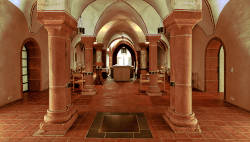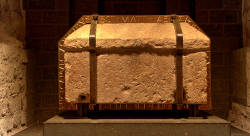Crypt
Crypts


The word crypt is derived from the Latin word crypta or the Greek word κρύπτη, kryptē, which mean actually concealed or private. The term is also used for cryptography and cryptology, which are mathematical procedures intended to transform a text or data until it is only readable by the owner. The architectural term crypt describes a mostly artificial cavern inside a church, a chapel in the church which is concealed, hidden, often underground. So the crypt is normally underground which means below the floor of the church, or at least below the raised floor around the altar.
The entrance is often from the side of the altar, which is more or less off limits to normal church visitors. That’s a typical aspect, as it is definitely intended to conceal something. Normally that’s the body of one or several members of the church, bishops, deans, sometime even a martyr or saint. So the church protects the sleep of those important people twofold, first by the church itself, then by the hidden location inside the church.
Crypts are not really underground, although most of them do not have windows, and so they actually look like being underground. Often crypts are the remains of a former church, which existed on the same place before the current church was built. The old church is destructed to a level about two to three meters above the old floor, then the rest is covered by a new ceiling, which becomes the new floor of the church.
Depending on their actual use, the crypt borders several other types of subterranea: the
 Cave Tomb
if it is simply a burial place, the
Cave Tomb
if it is simply a burial place, the
 Catacombs
if many people are buried here, and the
Catacombs
if many people are buried here, and the
 Cave Church
if it is mainly used for services.
Cave Church
if it is mainly used for services.
 Crypt - Wikipedia (visited: 15-JUL-2012)
Crypt - Wikipedia (visited: 15-JUL-2012) CATHOLIC ENCYCLOPEDIA: Crypt (visited: 15-JUL-2012)
CATHOLIC ENCYCLOPEDIA: Crypt (visited: 15-JUL-2012)
 Index
Index Topics
Topics Hierarchical
Hierarchical Countries
Countries Maps
Maps Search
Search